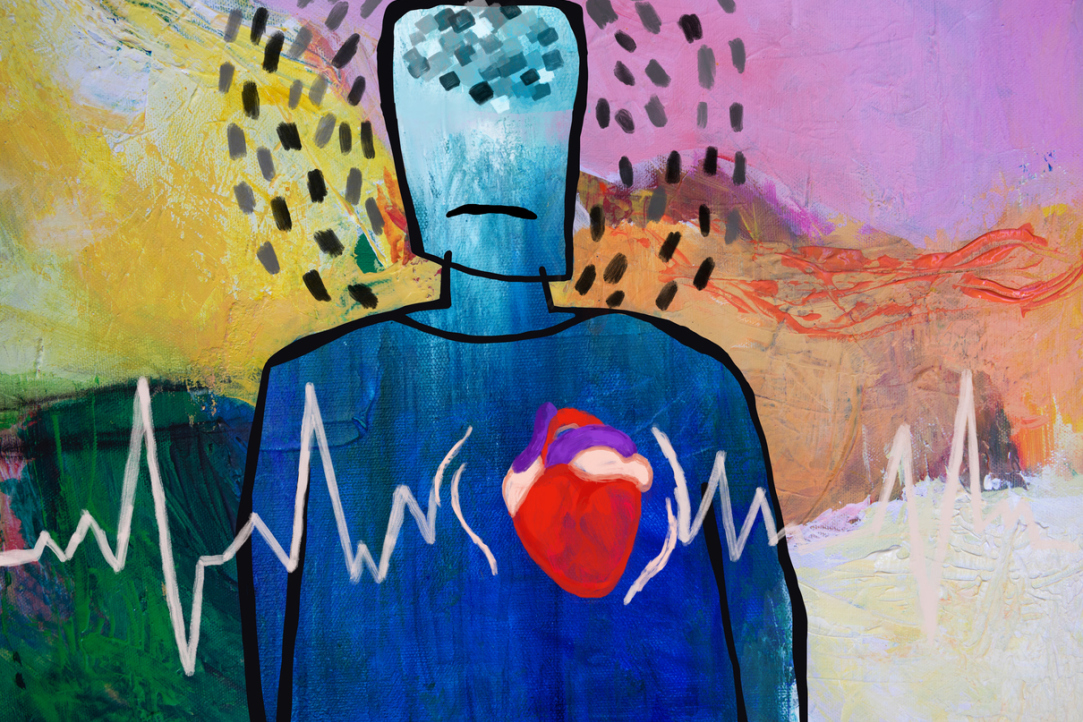HSE Scientists Propose Using Heart Rate Analysis to Diagnose Anxiety and Depression

A group of scientists at HSE University have discovered how anxiety and depression can be diagnosed by analysing heart rate. It turns out that under mental stress, the heart rate of individuals with a predisposition to mental health disorders differs from that of healthy individuals, especially when performing more complex tasks. These changes in cardiovascular parameters can even be detected using a pulse oximeter or a smartwatch. The study findings have been published in Frontiers in Psychiatry.
According to the World Health Organization, one in five adults under the age of 30 suffers from depression or an anxiety disorder. To prevent the development of mental health conditions and treat them effectively, reliable personalised diagnostic methods are needed.
Today, many technology companies are developing mental health analysis systems based on heart rate data. Various wearable devices, such as smartwatches, bracelets, rings, and others, are used for this purpose. However, it is important not only to record changes in heart rate but also to interpret them accurately.
Scientists at HSE University, in collaboration with the Russian Academy of Sciences Institute of Higher Nervous Activity and Neurophysiology, conducted a study to determine whether signs of depression and anxiety can be detected through changes in heart rate during cognitive tasks. They performed an experiment with 90 subjects, aged 18 to 45, some of whom had a history of anxiety and depression episodes.
Participants completed memory and attention tasks that gradually increased in complexity: they were instructed to view images of coloured balls and compare each one with the previous one to identify colour matches. As the difficulty level increased, participants had to memorise more balls and colours.
During the experiment, participants' heart rates were recorded using an electrocardiogram (ECG), while simultaneously photoplethysmography (PPG) was conducted to analyse heart function based on changes in blood volume in peripheral vessels. This simple, non-invasive method allows data to be read from the finger or wrist; PPG is the technology used in all wearable devices today.

Data analysis revealed that individuals with higher levels of anxiety or depression exhibited more pronounced changes in heart rate, particularly during complex tasks.
'When faced with a challenging task, people experience stress. They can make mistakes, which is normal and does not necessarily indicate a mental health issue. However, at a critical point of increasing complexity—when the task is still manageable but requires maximum attention—individuals with signs of mental disorders exhibit a higher average heart rate, resulting in a more pronounced and distinct pattern of heart rate variability,' explains Evgeniia Alshanskaia, Junior Research Fellow at the Institute for Cognitive Neuroscience.
A key aspect of the experiment was the comparison of data obtained using EEG and PPG. Although EEG is traditionally regarded as a more reliable method for measuring heart rate variability, the study indicated that PPG might be a more sensitive tool for assessing depression and anxiety. The scientists attribute this to the specific characteristics of the sympathetic nervous system.
'Under stress, noradrenaline, which is linked to attention, is activated first, followed by the activation of adrenaline, which prepares the body for action and triggers the "fight or flight" response. Our heart rate increases, and our blood pressure rises. Noradrenaline also acts on receptors that induce vasoconstriction. At this stage, changes in the pulse wave can be observed using PPG. Only afterward is adrenaline released from the adrenal glands, which amplifies and prolongs the body's stress response, causing the heart to beat faster. Subsequently, changes are observed on the ECG. This indicates that PPG is a relatively reliable method that is also more accessible, faster, and informative compared to ECG,' according to Alshanskaia.
The study demonstrates that changes in heart rate in response to increasing cognitive load can serve as an early biomarker for anxiety and depressive disorders. Additionally, the findings from the experiment open new opportunities for developing algorithms for wearable devices and applications that can monitor a person’s psychological state in real time. Early, personalised, and non-invasive diagnosis of depressive and anxiety disorders through heart rate analysis could significantly transform the approaches to treatment and prevention of mental health conditions in the future.
The study was conducted within the framework of the Strategic Project 'Success and Self-Sustainability of the Individual in a Changing World' (Priority 2030 programme).
See also:
Script Differences Hinder Language Switching in Bilinguals
Researchers at the HSE Centre for Language and Brain used eye-tracking to examine how bilinguals switch between languages in response to context shifts. Script differences were found to slow down this process. When letters appear unfamiliar—such as the Latin alphabet in a Russian-language text—the brain does not immediately switch to the other language, even when the person is aware they are in a bilingual setting. The article has been published in Bilingualism: Language and Cognition.
HSE Experts Highlight Factors Influencing EV Market Growth
According to estimates from HSE University, Moscow leads in the number of charging stations for electric vehicles in Russia, while Nizhny Novgorod ranks first in terms of charging station coverage, with 11.23 electric vehicles per charging station, compared to 14.41 in Moscow. The lack of charging infrastructure is one of the key factors limiting the growth of the electric vehicle market. This is stated in the study titled ‘Socio-Economic Aspects of Introducing Electric Vehicles in Commercial Transportation’ conducted by experts from the Institute of Transport Economics and Transport Policy Studies at HSE University.
Machine Learning Links Two New Genes to Ischemic Stroke
A team of scientists from HSE University and the Kurchatov Institute used machine learning methods to investigate genetic predisposition to stroke. Their analysis of the genomes of over 5,000 people identified 131 genes linked to the risk of ischemic stroke. For two of these genes, the association was found for the first time. The paper has been published in PeerJ Computer Science.
First Digital Adult Reading Test Available on RuStore
HSE University's Centre for Language and Brain has developed the first standardised tool for assessing Russian reading skills in adults—the LexiMetr-A test. The test is now available digitally on the RuStore platform. This application allows for a quick and effective diagnosis of reading disorders, including dyslexia, in people aged 18 and older.
Low-Carbon Exports Reduce CO2 Emissions
Researchers at the HSE Faculty of Economic Sciences and the Federal Research Centre of Coal and Coal Chemistry have found that exporting low-carbon goods contributes to a better environment in Russian regions and helps them reduce greenhouse gas emissions. The study results have been published in R-Economy.
Russian Scientists Assess Dangers of Internal Waves During Underwater Volcanic Eruptions
Mathematicians at HSE University in Nizhny Novgorod and the A.V. Gaponov-Grekhov Institute of Applied Physics of the Russian Academy of Sciences studied internal waves generated in the ocean after the explosive eruption of an underwater volcano. The researchers calculated how the waves vary depending on ocean depth and the radius of the explosion source. It turns out that the strongest wave in the first group does not arrive immediately, but after a significant delay. This data can help predict the consequences of eruptions and enable advance preparation for potential threats. The article has been published in Natural Hazards. The research was carried out with support from the Russian Science Foundation (link in Russian).
Centre for Language and Brain Begins Cooperation with Academy of Sciences of Sakha Republic
HSE University's Centre for Language and Brain and the Academy of Sciences of the Republic of Sakha (Yakutia) have signed a partnership agreement, opening up new opportunities for research on the region's understudied languages and bilingualism. Thanks to modern methods, such as eye tracking and neuroimaging, scientists will be able to answer questions about how bilingualism works at the brain level.
How the Brain Responds to Prices: Scientists Discover Neural Marker for Price Perception
Russian scientists have discovered how the brain makes purchasing decisions. Using electroencephalography (EEG) and magnetoencephalography (MEG), researchers found that the brain responds almost instantly when a product's price deviates from expectations. This response engages brain regions involved in evaluating rewards and learning from past decisions. Thus, perceiving a product's value is not merely a conscious choice but also a function of automatic cognitive mechanisms. The results have been published in Frontiers in Human Neuroscience.
AI Predicts Behaviour of Quantum Systems
Scientists from HSE University, in collaboration with researchers from the University of Southern California, have developed an algorithm that rapidly and accurately predicts the behaviour of quantum systems, from quantum computers to solar panels. This methodology enabled the simulation of processes in the MoS₂ semiconductor and revealed that the movement of charged particles is influenced not only by the number of defects but also by their location. These defects can either slow down or accelerate charge transport, leading to effects that were previously difficult to account for with standard methods. The study has been published in Proceedings of the National Academy of Sciences (PNAS).
Electrical Brain Stimulation Helps Memorise New Words
A team of researchers at HSE University, in collaboration with scientists from Russian and foreign universities, has investigated the impact of electrical brain stimulation on learning new words. The experiment shows that direct current stimulation of language centres—Broca's and Wernicke's areas—can improve and speed up the memorisation of new words. The findings have been published in Neurobiology of Learning and Memory.



